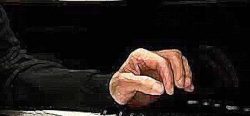 There are two major techniques for classical piano. One is the French school in which you simply push down the keys. This is the most common technique and has been used by many of the world’s greatest pianists. The other is the Russian technique. In this technique, the pianist creates tension in his or her fingers before striking the key. Then, the actual striking of the key becomes the resolution to the tension. This technique produces the most beautiful bell like tones coming from the piano.
There are two major techniques for classical piano. One is the French school in which you simply push down the keys. This is the most common technique and has been used by many of the world’s greatest pianists. The other is the Russian technique. In this technique, the pianist creates tension in his or her fingers before striking the key. Then, the actual striking of the key becomes the resolution to the tension. This technique produces the most beautiful bell like tones coming from the piano.
There is more to this technique than this principle, such as weightless of the arms, etc. But the structural principle is that the tension created in the fingers comes before the activation of the note. Tension first, and then the action becomes the resolution.
I learned about this technique from the very famous piano teacher Madame Chaloff. This was while I was going to the Boston Conservatory, and while I am not a pianist, my composition teacher had studied with her. So had Leonard Bernstein, Keith Jarrett, Chick Corea, George Shearing, and so many more great musicians.
Why this technique should be interesting to those of us who are not pianists is that it illustrates one of the most important principles of the creative process, and that is tension comes before action. As in archery, tension comes before releasing the arrow.
The basic structure in the creative process is structural tension, the relationship between your desired state and the actual state in relationship to the desired state. Two critical data points: know what you want to create; know where you are in relationship to that outcome. And remember, this tension is not psychological. It is not stress, anxiety or pressure. It is structural.
Most people do not use this structure. Instead, they react or respond to circumstances they find themselves in, or, in the future, might find themselves in. This often means a lot of problem solving. One problem after another. As we’ve said, you can solve all of your problems and still not have what you want. Problem solving is not creating, and creating is not problem solving.
A few weeks ago, I led my annual workshop for artists, The Art of the Creative Process. This is one of my favorite courses to teach because it is about creating art, and using structural dynamics to increase the artist’s ability to further master his or her approach. The artists in the course are consummate professionals. They work in various mediums: film, music, visual art, writing, dance, etc. They all go through the same set of projects we set up for them. They all write, do photography, do other visual exercises, structure plots for screenplays, and so on.
One of the major principles is Russian piano technique, as least as a principle, first the tension, and then the creative process is the resolution to the tension. They structure a dialogue, but are not allowed to write it for a while. This space between constructing the form and actually writing the piece consolidates the tension. It is like putting tension in the fingers before striking the keys. Then they have a very short time in which to write the piece. 7 minutes. They write very fast and very well indeed.
The results are amazing. Many of them have never written before, but everyone, experienced or not, creates a wonderful piece. Before this exercise, most of them would have thought this was impossible. But, once they have experienced this and several other examples of “Russian piano technique” they begin to experience one of the great secrets of the creative process, tension before creating.
Now, these people were experienced and masterful creators to begin with. Many of them at the top of their art and craft. But still, there was this one missing piece to the puzzle.
Structural tension is THE most powerful form for creating anything, including your own life. When in doubt, remember Russian piano technique, and firmly establish structural tension before you act.



